If you’re looking for an easy and rewarding way to add some greenery to your space, snake plant propagation may be the best option what you need. It is important to understand how snake plants reproduce and the different methods you can use.

So if you are a real plant lover and you are going to choose a low-maintenance or you haven’t enough time for plantation then the snake plant is also best for you.
Not only is it an easy process, but it’s also an especially exciting way to bring a new burst of greenery into your space.
In this article, we’ll explore the different methods for snake plant propagation and provide you with valuable tips for success.
In This Article
- 1 Why should I propagate snake plants?
- 2 Understanding of Snake Plant Propagation
- 3 Snake Plant Propagation by Division
- 4 Leaf Cuttings Snake Plant Propagation
- 5 Snake Plant Propagation in Water
- 6 Snake Plant Propagation in Soil
- 7 Snake Plant Propagation by Rhizome Division
- 8 Propagation Tips and Common Mistakes to Avoid
- 9 Common Mistakes to Avoid
- 10 Snake Plant Care for Propagated Plants
- 11 Troubleshooting of Snake Plant Propagation Problems
- 12 FAQ:
Why should I propagate snake plants?
Snake plant propagation is an effortless and exciting way to expand your indoor garden collection.
There are several different propagation methods, including through division, leaf cuttings, water, soil, and rhizome division.
By following the right techniques and providing proper care, you can easily propagate your snake plants with success and enjoy their beauty.
It’s a cost-effective way to add more greenery to your space and share the benefits of snake plants with others.
Understanding of Snake Plant Propagation
Snake plants, also known as sansevieria. It belongs to the succulent family, which means they store water in their leaves and stems to survive in dry environments. These plants are known for their hardiness and adaptability.
Propagation is the process of creating new plants from a parent plant, and snake plants can be propagated in several ways. The most common methods include division, leaf cuttings, water, and soil propagation.
Each method has its advantages and disadvantages, and we will discuss them in detail later in this article.
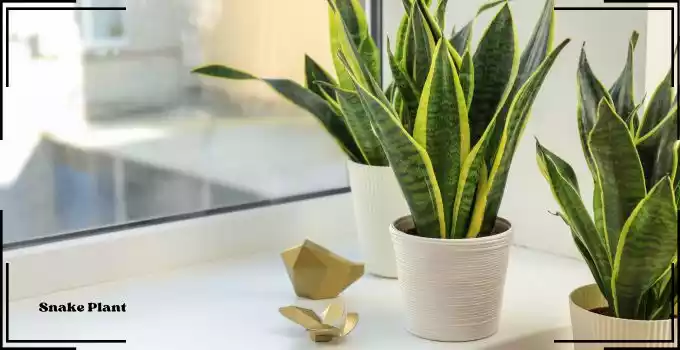
To create new plants, it is important to have a basic understanding of how snake plants reproduce. Snake plants propagate through runners also known as rhizomes. This type of plant can grow horizontally under the soil.
These runners produce roots and new shoots, which grow into separate plants. Understanding this basic process is essential to successfully propagating snake plants and expanding your collection.
Snake Plant Propagation by Division
Propagating snake plants by division is a straightforward method that involves dividing the plant into smaller sections. This technique is ideal for mature snake plants that have started to outgrow their pots.
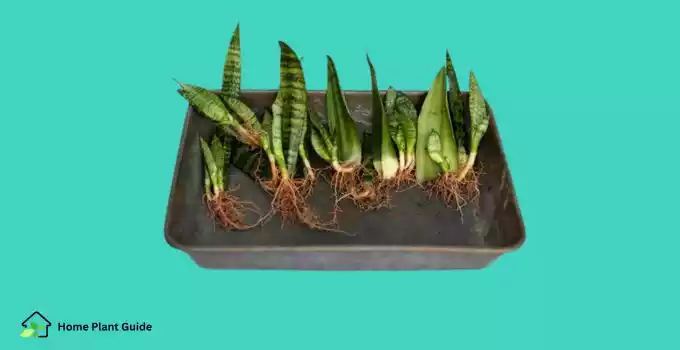
To begin, gently remove the snake plant from its container and shake off any excess soil. Use a clean, sharp knife or shears to cut the plant into smaller sections, making sure each section has at least two leaves and a portion of rhizome.
After dividing the snake plant, plant the new sections in separate pots filled with fresh soil.
Spread water thoroughly on the plant. It should be placed in a bright and indirect light location.
Within a few weeks when new growth should appear, indicating successful propagation.
Leaf Cuttings Snake Plant Propagation
Leaf cuttings propagation is a simple, yet effective method of growing new snake plants. It is best done during spring and summer when the plant is actively growing. Here are the step-by-step instructions:
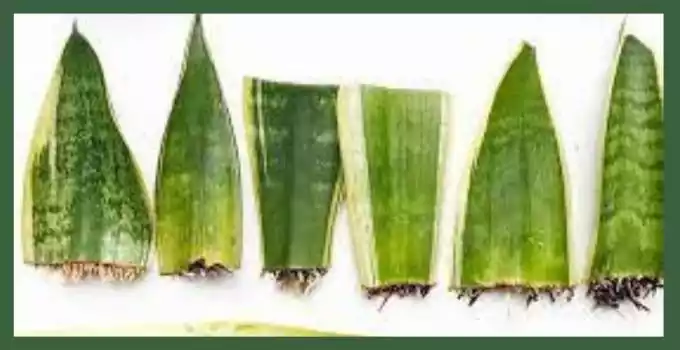
Step 01
Identify a healthy leaf on your snake plant. Using a clean, sharp knife or pruning shears, cut the leaf at the base. Make sure the leaf is at least 2-3 inches long and has no signs of damage or disease.
Step 02
Place the leaf-cutting in a container filled with well-draining potting soil, covering the stem about an inch deep.
Step 03
Water the soil well, making sure it is moist but not waterlogged.
Step 04
Place the container in a bright, indirect light location.
Step 05
Maintain a warm, humid environment by covering the container with a plastic bag or clear plastic wrap. Punch a few holes in the plastic to ensure proper airflow.
Step 06
Check the soil regularly to ensure it stays moist, but avoid overwatering. After a few weeks, check for roots by gently tugging on the leaf. If the roots have formed, the new plant is ready to be potted up.
Leaf cuttings propagation is a surefire way to multiply your snake plant collection. It is a low-maintenance process that requires minimal effort.
Snake Plant Propagation in Water
Water propagation is an easy and low-maintenance method to propagate snake plants, making it perfect for beginners.
This method works by placing the cuttings in water until roots form, then transferring them into soil for further growth.

Here are the step-by-step instructions for snake plant water propagation:
Step 01
Start by selecting a healthy snake plant leaf and cutting it close to the soil level.
Step 02
Remove any lower leaves below the cut and allow the cutting to callus over for a few days.
Step 03
Fill a jar or container with fresh water and insert the cutting with the cut side down.
Step 04
Place the jar or container in a bright, indirect light, and change the water every 2-3 days to prevent mold or bacteria growth.
Step 05
Within a few weeks, roots should begin from the bottom of the cutting.
Once the roots are around 2 inches long, you can transfer the plant into soil, or leave it in water if you prefer.
Step 06
During the process, ensure that the cutting stays moist but not waterlogged.
Avoid using distilled water since snake plants prefer some mineral content in their water. If your tap water has excessive chlorine, you can use a water filter or leave the water open for 24 hours to dechlorinate.
One common mistake to avoid in snake plant water propagation is using a container that’s too small to hold the cutting in place.
Please make sure that the container you use is large enough to hold the cutting and keep it in place.
Read More plantation Techniques:
Snake Plant Propagation in Soil
If you prefer a more traditional approach to propagating snake plants, soil propagation is an excellent option. This method uses soil to root snake plant cuttings instead of water or division.
The process is simple and can result in healthy new plants.
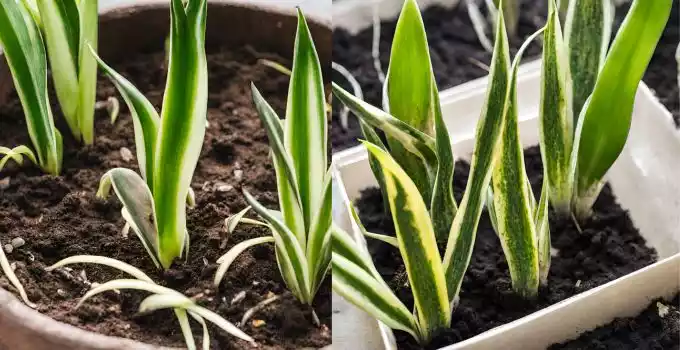
Step 01
To get started, take a healthy leaf cutting from the mother plant. Make sure it’s about 3-4 inches long with a few leaves still attached.
Step 02
Next, dip the cutting in rooting hormone to encourage growth and place it in moist, well-draining soil.
Pro tip: Use a pot with drainage holes to ensure the soil doesn’t become waterlogged, which can cause root rot.
Step 03
Once the cutting is planted, it is essential to keep the soil moist but not soaked. Excess water can cause the cutting to rot. So be careful not to overwater.
Step 04
Within a few weeks, you should notice new growth emerging from the soil, indicating successful rooting.
As with any propagation method, it’s important to provide the new plant with adequate light and nutrients once it starts growing.
Please Note: Keep the soil moist, but not waterlogged and avoid direct sunlight until the new plant is established.
Snake Plant Propagation by Rhizome Division
If you have larger snake plants or ones with multiple rhizomes then propagating by rhizome division can be an excellent method to expand your snake plant collection.
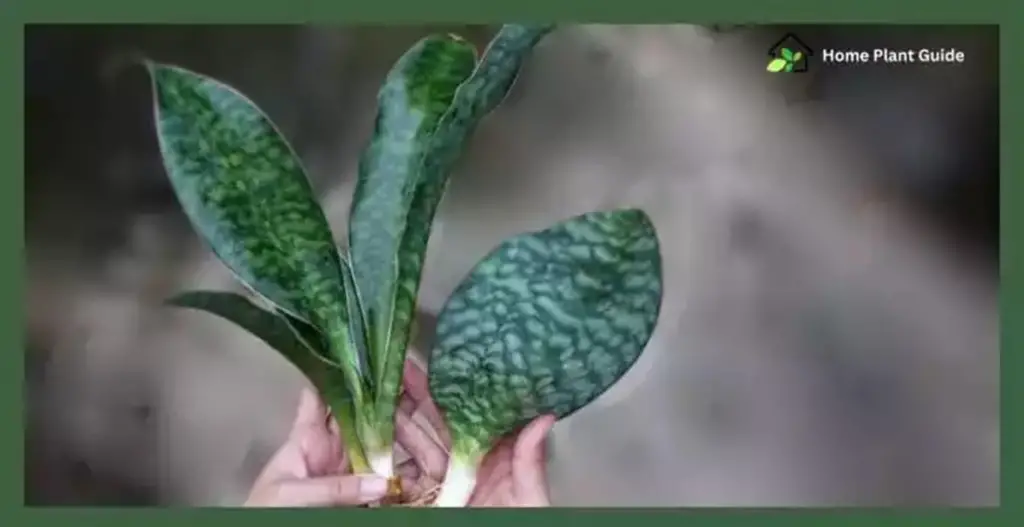
Rhizomes are the underground stems of the plant, and dividing them allows each new section to grow into its plant. Follow these simple steps to propagate snake plants through rhizome division:
1. Carefully remove the snake plant from its pot and gently shake off any excess soil.
2. Inspect the plant for any rhizomes that appear separate from the main stem.
3. Using a sharp and clean knife, cut the rhizome away from the main stem, being sure to leave some roots attached to the rhizome.
4. Prepare a pot with fresh potting soil and plant the rhizome in the soil with the cut side facing up above the soil line.
5. Water the new plant and place it in a bright, indirect location to encourage healthy growth.
Propagation by rhizome division is a straightforward and reliable method for snake plant propagation.
Propagation Tips and Common Mistakes to Avoid
When propagating snake plants, make sure to use sharp and clean tools. Also, provide adequate lighting and appropriate temperature.
Avoid overwatering, and be patient as it may take some time for the cuttings to root and grow.
Successfully propagating snake plants requires patience, attention, and proper care. Below are some helpful tips and common mistakes to avoid for a successful propagation process.
Propagation Tips:
- Choose a healthy and mature mother plant for the best results.
- Use clean tools to avoid spreading diseases.
- If propagating through soil or water, make sure the soil or water is moist but not waterlogged.
- Provide ample indirect sunlight for the cuttings to root.
- Be patient and avoid disturbing the cuttings until they have developed roots.
Common Mistakes to Avoid
| Mistake | Consequence |
|---|---|
| Overwatering the cuttings | May cause root rot and kill the cuttings |
| Placing cuttings in direct sunlight | May cause the cuttings to dry up or scorch |
| Using contaminated soil or water | May spread diseases and kill the cuttings |
| Disturbing cuttings too soon | May damage the fragile roots and prevent successful propagation |
By following these tips and avoiding common mistakes, you can increase your chances of successful snake plant propagation.
Snake Plant Care for Propagated Plants
Now that you have successfully propagated your snake plants, it’s time to ensure they continue to thrive.
These are the essential care tips for your propagated snake plants:
Light
Snake plants can tolerate low-light conditions, but they prefer bright, indirect sunlight. Keep your plant in a location with at least four hours of natural light a day.
Water
Overwatering is the most common mistake people make with snake plants. Allow the soil to dry out between watering, and make sure the pot has good drainage. Water your plant less frequently in winter.
Soil
Snake plants prefer well-draining soil. Use a potting mix with perlite, sand, or vermiculite to ensure good drainage.
Temperature
Snake plants prefer temperatures above 50°F (10°C) and can tolerate temperatures up to 85°F (29°C). Keep them away from cold drafts in winter.
Fertilizer
Fertilize your snake plant once a month during the growing season like spring and summer with a balanced fertilizer. No fertilizer is necessary during the dormant season from fall to winter.
With proper care, your propagated snake plants will continue to grow and thrive, adding beauty and a touch of nature to your indoor space.
Troubleshooting of Snake Plant Propagation Problems
Propagation can sometimes encounter problems that may prevent the successful growth of your snake plants. You can address some of the most common propagation issues and provide viable solutions to help you overcome them.
Potential snake plant propagation problems and solutions
| Problem | Solution |
|---|---|
| The plant cutting rots or becomes mushy | Ensure that your cutting is not left in overly moist soil or water. Ensure proper drainage and wait for the cutting to dry out before replanting. |
| The plant cutting dries out and dies | Keep your cutting in a humid environment and avoid placing it in direct sunlight. Regularly mist the cutting to keep it moist, but not oversaturated. |
| The plant cutting doesn’t root | Make sure the cutting is healthy and choose the right soil type and rooting hormone. Keep the cutting in a warm, bright place under a humidity dome. |
| The propagated plant grows slowly | Ensure that the cutting is getting enough light, but not direct sunlight. Water the plant moderately and avoid fertilizing until it is well established. |
Conclusion
We hope that you have found our guide to snake plant propagation helpful and informative.
With the methods outlined in this article, you can easily expand your snake plant collection and enjoy the many benefits that these plants have to offer.
Remember to be patient and take your time with the propagation process, and don’t hesitate to reach out for help if you encounter any issues.
As you continue to care for your newly propagated snake plants, be sure to follow the essential care tips we have provided to ensure their continued growth and health.
With a little bit of effort, you can create a beautiful and healthy snake plant garden in your home or office.
FAQ:
Q: What is snake plant propagation?
Snake plant propagation is the process of multiplying snake plants by creating new plants from existing ones. There are several methods of propagation including division, leaf cuttings, water propagation, soil propagation, and rhizome division.
Q: What is leaf-cutting propagation?
Leaf cuttings propagation involves taking a healthy leaf from a snake plant and allowing it to root in water or soil. Once the leaf develops roots, it can be planted in a separate pot to grow a new snake plant.
Q: Can I propagate snake plants in water?
Yes, snake plants can be propagated in water. Simply place leaf cuttings or rhizomes in a container filled with water and wait for them to develop roots. Once rooted, transfer them to soil for further growth.
Q: How do I propagate snake plants using soil?
To propagate snake plants using soil, take leaf cuttings or rhizomes and plant them directly in a well-draining potting mix. Keep the soil moist and place the cuttings or rhizomes in a warm, bright location for optimal growth.
Q: What are some common mistakes to avoid during snake plant propagation?
Common mistakes to avoid include using unhealthy or damaged plant material, overwatering or underwatering the cutting.
Exposing them to bright sunlight or extreme temperatures, and not providing proper care and maintenance during the rooting and growth stages.





